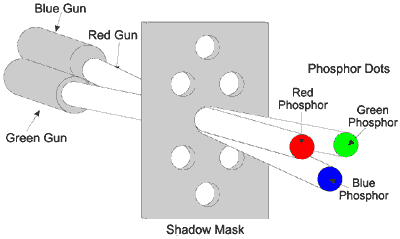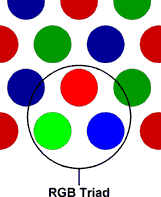Before the stream of electrons produced by the CRT’s cathode reach the phosphor coated faceplate, it encounters the shadow mask, a sheet of metal etched with a pattern of holes. The mask is positioned in the glass funnel of the CRT during manufacture and the phosphor is coated onto the screen so that electrons coming from the red, green and blue gun positions only land on the appropriate phosphor.
Stray electrons strike the shadow mask and are absorbed by it, generating a great deal of heat, which in turn causes the metal to expand. To allow flatter CRTs to be made, the metal most commonly used now for shadow masks is Invar, an alloy of iron and nickel. The metal has a low coefficient of expansion and its name derives from the supposed invariability of its dimensions when heat is applied. In reality, its dimensions are not completely invariable and the build up of heat in a shadow mask can lead to a form of distortion known as doming, where the centre of the mask bulges towards the faceplate slightly.

An alternative to the shadow mask which is less prone to distortion, the aperture grille, was included as part of the design of Trinitron CRTs by Sony in 1968 and Mitsubishi in its Diamondtron products in the early 1990s.

